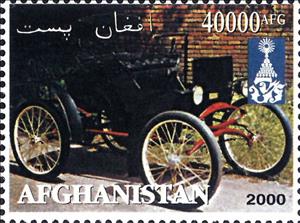Stamp: Antique Cars (Afghanistan 2000)
Antique Cars (Afghanistan 2000)
01 January (Afghanistan ) within release Antique Cars (2000) goes into circulation Stamp Antique Cars face value 40,000 Afghan afghani
| Stamp Antique Cars in catalogues | |
|---|---|
| Colnect codes: | Col: AF 2000-02/2 |
Stamp is square format.
This item has been denounced in Afghanistan 2003 UPU Circular 2 as illegally produced without the authorization of the postal administration. They have no postal validity. Please view Afghanistan stamps in the main stamp category to see validated stamp issues. Produced by the British counterfeit producer and still being distributed by associated counterfeit stamp dealers to this day. Avoid sellers of these!Also in the issue Antique Cars (2000):
- Mini Sheet - Antique Cars face value 9*50000;
- Mini Sheet - Antique Cars face value 9*20000;
- Stamp - Antique Cars face value 40,000;
- Stamp - Antique Cars face value 40,000;
- Stamp - Antique Cars face value 40,000;
- Stamp - Antique Cars face value 40,000;
- Stamp - Antique Cars face value 40,000;
- Stamp - Antique Cars face value 40,000;
- Stamp - Antique Cars face value 40,000;
- Stamp - Antique Cars face value 40,000;
- Stamp - Antique Cars face value 40,000;
|
Data entry completed
53%
|
|
|---|---|
| Stamp Antique Cars in digits | |
| Country: | Afghanistan |
| Date: | 2000-01-01 |
| Print: | Offset lithography |
| Emission: | Illegal |
| Format: | Stamp |
| Face Value: | 40,000 Afghan afghani |
Stamp Antique Cars it reflects the thematic directions:
The automotive industry comprises a wide range of companies and organizations involved in the design, development, manufacturing, marketing, selling, repairing, and modification of motor vehicles. It is one of the world's largest industries by revenue (from 16% such as in France up to 40% in countries such as Slovakia).
A car is a wheeled, self-powered motor vehicle used for transportation and a product of the automotive industry. Most definitions of the term specify that cars are designed to run primarily on roads, to have seating for one to eight people, to typically have four wheels with tyres, and to be constructed principally for the transport of people rather than goods. The year 1886 is regarded as the birth year of the modern car. In that year, German inventor Karl Benz built the Benz Patent-Motorwagen. Cars did not become widely available until the early 20th century. One of the first cars that was accessible to the masses was the 1908 Model T, an American car manufactured by the Ford Motor Company. Cars were rapidly adopted in the United States of America, where they replaced animal-drawn carriages and carts, but took much longer to be accepted in Western Europe and other parts of the world.


